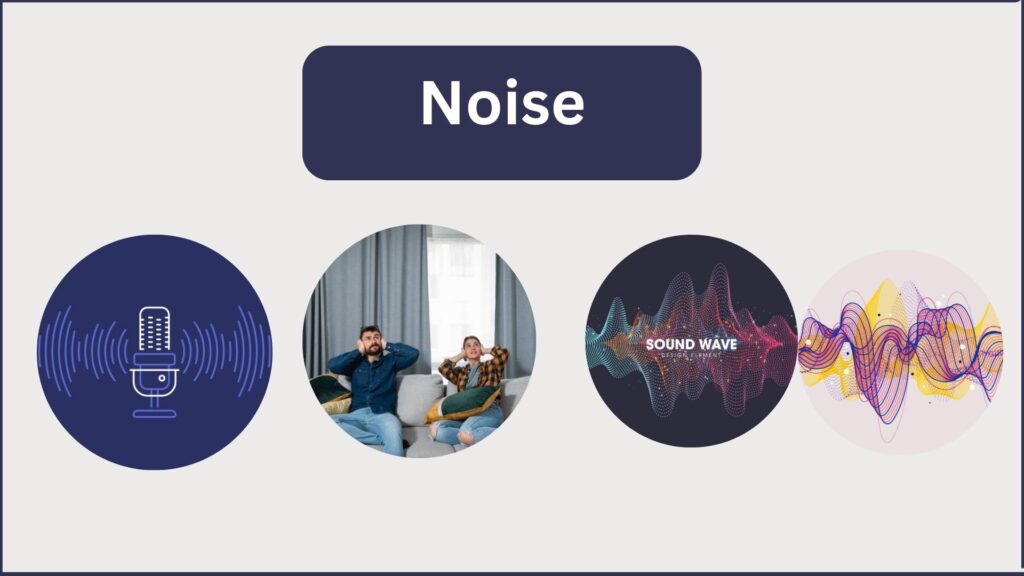Noise : Definition, factor, source & control measures
Noise
We have described in article :
Definition of Noise
Harmful effect of Noise
Sources of Noise
Control measure for noise of Noise
Effect of Noise exposure

Definition of Noise :
Noise : Wrong sound in the wrong place at the wrong time.
Properties : Noise has 2 important properties –
- Loudness/intensity : It depends upon the amplitude to the vibrations which initiated the noise. It is measured in decibels (dB).
- Frequency : The frequency is denoted as hertz (Hz). The human ear can hear frequencies from about 20 to 20,000 Hz.
The factors related to harmful effects of noise :
- Intensity : The loudness or intensity of sound depends on the amplitude of the acoustic vibration and is measured I decibel (dB).A daily exposure of 85 dB is about the limit people can tolerate without substantial damage to their hearing.
- Frequency : Frequency is denoted by Hertz. The sound frequencies audible to human ear range from 20 to 20000 Hz, but this range is reduced with age and other factors.
- Duration : The adverse effect of noise is proportional to the duration of the exposure and appears to be related to the total amount of energy reaching the inner air
- Nature : This refers to the distribution of the sound energy over time (stable, fluctuating, intermittent). Impulsive noise is particularly harmful.
Sources of sound pollution/noise :
- Industrial noise : Mining, tunneling, quarrying, heavy engineering & textile machines etc.
- Transportation :
.Surface of vehicular transportation, e.g. rail road, heavy trucks, motor cycles, automobiles.
.Aircraft’s
- Construction equipment.
- Amplified music.
- Animals.
Loudness of noise :
- Normal conversation: 60-65 dB.
- Whispering: 20-30 dB.
- Heavy street traffic: 60-80 dB.
- Boiler factories: 120 dB.
Control measures for noise :
- Control measures for noise : A variety of approaches are needed to control noise. These include –
- Careful planning of the cities : The following measure should be taken to reduce noise :
.Division of cities into zones with separation of areas concerned with industry & transport.
.The separation of the residential areas from the main street by means of wide green belts.
.Widening of main streets to reduce the level of noise penetration into dwelling.
- Control of vehicles : Heavy vehicles should not be routed into narrow streets. Vehicular traffic on residential streets should be reduced.
- To improve acoustic insulation of building : Installation that produce noise or disturbs the occupants within dwellings should be prohibited. Buildings should be sound-proof where necessary.
- Industries and railways : Special areas must be carmarked, outside the residential areas, for industries, for railways, marshalling yards and similar installations. Protective green belts must be laid between the installation and residential areas where necessary.
- Protection of exposed persons : Hearing protection is recommended for all workers who are consistently exposed to noise louder than normal.
- Legislation : Legislation should be adopted to for control of noise.
- Education : Education through all available media is needed to highlight the importance of noise as a community hazard.
Effects of noise exposure :
Auditory effects :
- Auditory fatigue (noise induced temporary threshold shift- NITTS) – In the 90 dB region and greatest at 4000-6000 Hz.
- Deafness :
- A daily exposure up to 85 dB is about limit people can tolerate without substantial damage to hearing.
- Repeated or continuous exposure to noise around 100 dB nay result in deafness.
- Single exposure to noise above 160 dB may rupture tympanic membrane.
Non-auditory effects :
- Interference with speech.
- Annoyance
- Efficiency
- Physiological changes : Rise of blood pressure, heart rate, breathing, intra-cranial pressure, increase sweating and giddiness, nausea, fatigue.
- Economic loss.

I was just seeking this info for a while. After six hours of continuous Googleing, at last I got it in your web site. I wonder what is the lack of Google strategy that don’t rank this type of informative sites in top of the list. Usually the top web sites are full of garbage.